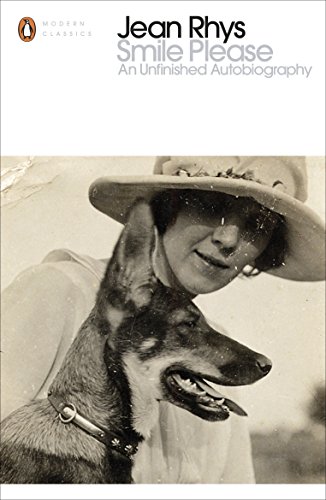Jean Rhys "Smile Please" (Penguin Modern Classics)

There is something sadly fitting about Smile Please ’s being an unfinished autobiography. According to her publisher Diana Athill in the volume's foreword, Rhys was reluctant to revisit in an autobiography painful aspects of her past that she had already treated in her novels. At the same time, Rhys was frustrated by her readers' tendency to assume all scenes and characters in her novels were drawn directly from her own life.
This explanation of Rhys’s decision to reverse herself and begin work on her autobiography seems logical, but too pat. I suspect, although I could be wrong, that Rhys, at the end of her life, felt the need to reach back into the past and try to touch her former self, a lonely girl, and later woman, who always felt isolated and apart. Smile Please is a touching and heartbreaking representation of the deep loneliness and alienation at the core of Rhys’s identity. At the same time, there is a clear sense of Rhys’s strength, talent, and beauty emerging from these pages.
The scattered feeling at the heart of Smile Please comes not only from the book’s format, but also from Rhys’s style of approaching her life obliquely. From her very first paragraphs, as she describes a photograph of herself as a young child, she depicts the past as ephemeral, and herself in the past as irretrievably isolated from herself in her present.
Throughout, Rhys continues to explore this strong sense of isolation and loss. She describes her inability to bridge the gap of race and status separating her from her family’s servants in the West Indies, a sense of separation that extended to her awareness of an unbridgeable chasm between herself and the West Indians living around her, particularly as she remembered an interaction between herself and an older black girl at her convent school, whom she was admiring and longing to befriend.
Rhys does not reflect much on the politics of race relations in the West Indies. She captures her childhood understanding, as if caught in amber, and holds it up for us to examine.
The second section of Smile Please focuses on Rhys’s life in England -- her struggles to feel at home in a cold, foreign England, her aunt’s frustrations over Rhys’s odd ways (for example, her taking hot baths in English boarding houses), Rhys’s attempts to feel a part of life at school in spite of her odd clothes. Her intermittent career as a chorus girl brought home to her the feeling of living precariously, with unpredictable lodging, constant worries over money, and the constant need to be on guard and aware of some men’s sexual predation on chorus girls. Throughout the rest of the book, Rhys continues to refer obliquely and glancingly to important relationships and events in her life. Her connection with lovers and former lovers often is played out via impersonal intermediaries. In some of the most heartbreaking writing in her autobiography, Rhys remembers her struggles to eke out a living for herself and maintain her dignity.
Smile Please is a heartbreaking autobiography, but there is beauty in the facets of Rhys’s story. Her writing is spare, direct, and often lovely. Her unflinching depiction of herself makes me ache for her, but also admire her. Her ability to rise above her pain, to turn it into art, provides us now with a means to connect with her after her death.








